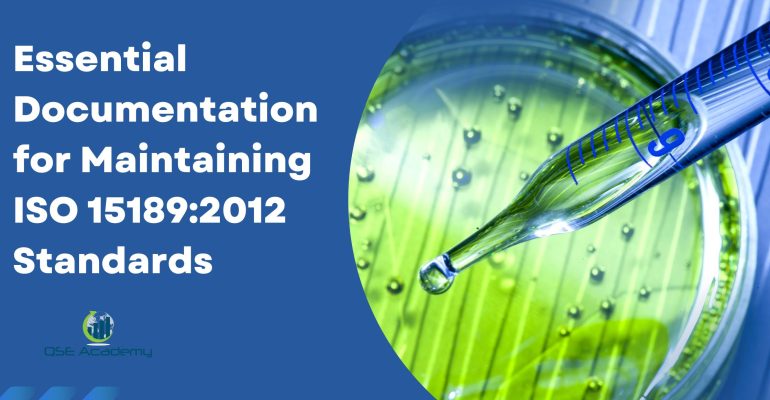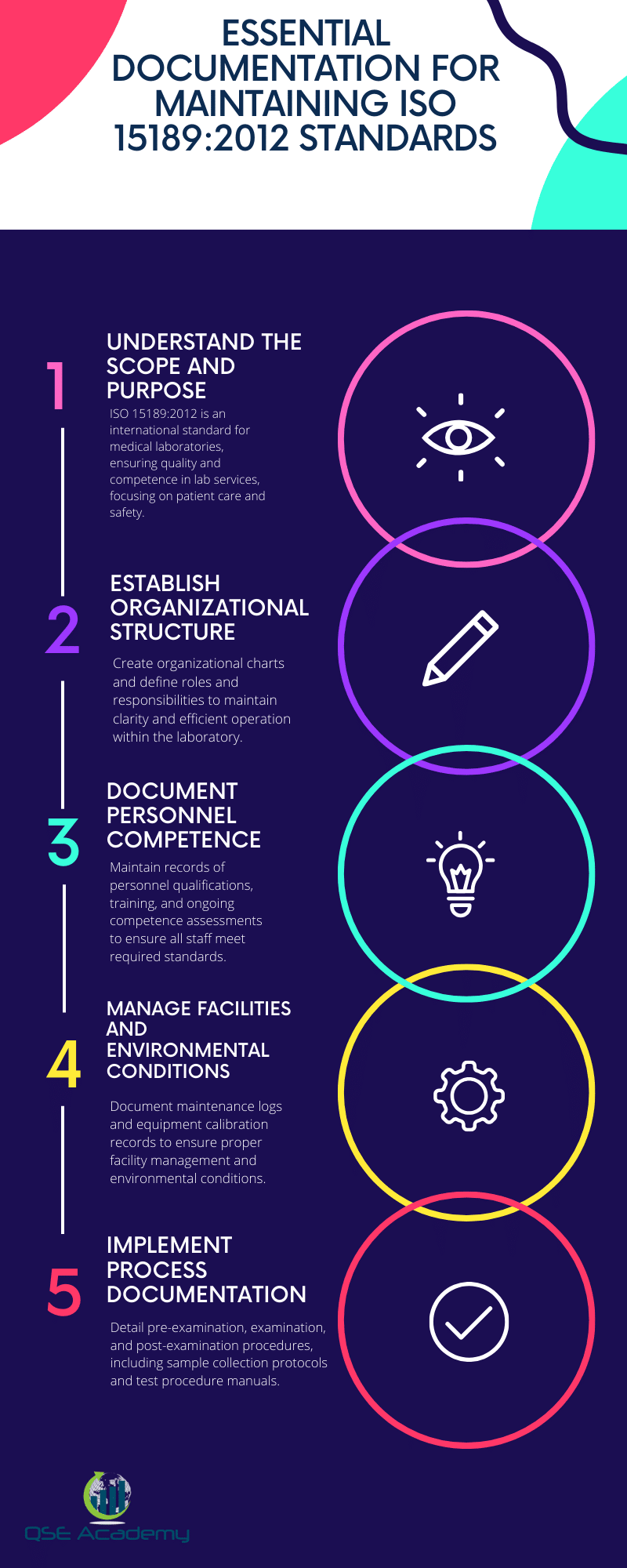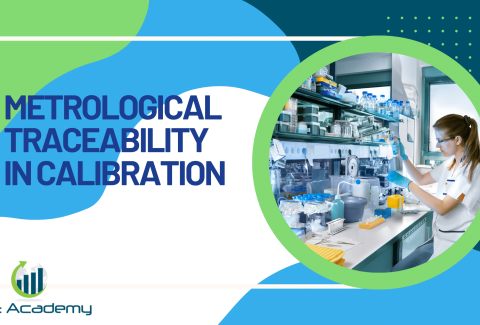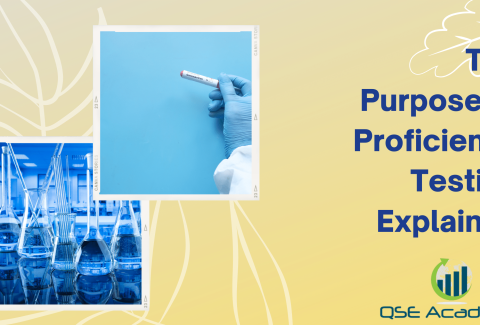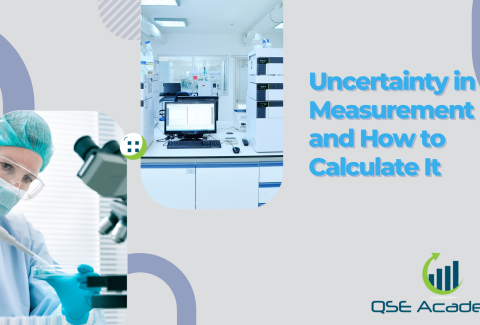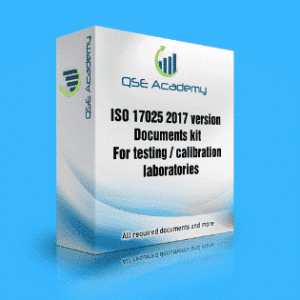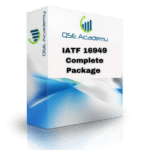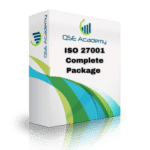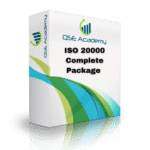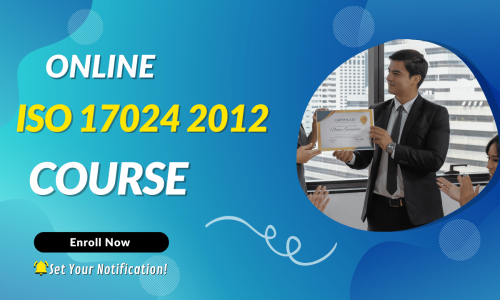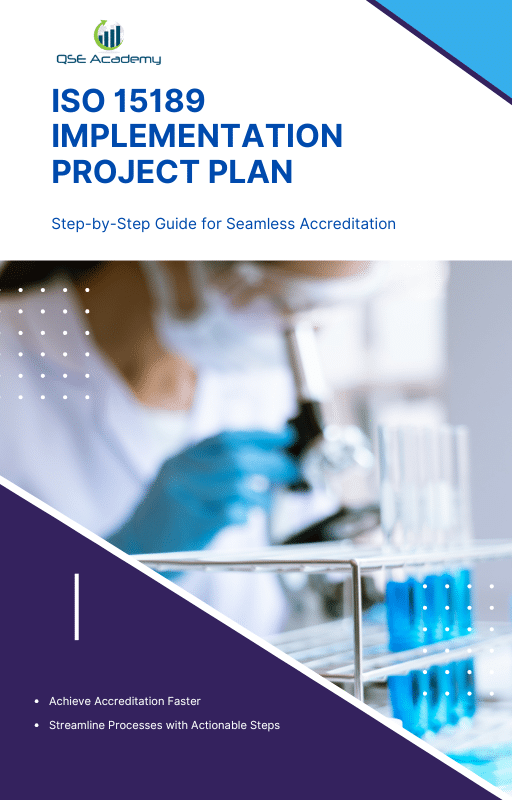Essential Documentation for Maintaining ISO 15189:2012 Standards
A laboratory’s quality of work can hinge on its adherence to international standards. ISO 15189:2012 is more than just a badge of quality for medical labs—it’s a comprehensive approach to operational excellence. This article seeks to illuminate the path to compliance through meticulous documentation.
Achieving and maintaining the ISO 15189:2012 standards requires a tapestry of intricate and systematic documentation. From outlining organizational roles to demonstrating continuous quality improvement, the trail of paperwork is extensive but beneficial. We will break down the essential documentation that underpins the entire structure of ISO 15189:2012 compliance.
As we delve into the world of standards and their upkeep, each section of this article will guide you through a different category of the necessary documents. Prepare to navigate the labyrinth of guidelines that constitute the backbone of a laboratory’s quality management system.
Introduction
ISO 15189:2012 is an international standard specifically developed for medical laboratories. It outlines the requirements for quality and competence that such laboratories must meet to ensure their services are reliable and maintain high patient care standards. The documentation required by ISO 15189:2012012 plays a crucial role, as it establishes a framework for consistency, traceability, and continual improvement of laboratory practices. This ISO standard harmonizes with the principles of ISO/IEC 17025 and ISO 9001:2008, incorporating the specific needs of medical laboratory services, such as the handling of clinical samples, determining biological reference intervals, and the competence of testing and calibration laboratories.
Originally introduced in 2003, the standard underwent minor corrections and updates, leading to its current version, ISO 15189:2012. Over time, it has evolved to adapt to the advancing technology and changing needs of laboratory management in the clinical laboratory sciences. This evolution ensures that laboratories registering under this certification maintain acceptable environmental conditions, meet the requirements for quality and safety, and adhere to the principles laid out by the Clinical and Laboratory Standards Institute (CLSI) and other regulatory and accreditation bodies.
Table: Key Elements of ISO 15189:2012 Documentation Requirements
| Section | Documentation Requirement |
| Quality Management Systems | Policies, processes, and procedures for auditing management systems |
| Document Control | Procedures for revisions and approval of documents |
| Examination Procedures | Instructions for use of diagnostic test systems and equipment |
| Continual Improvement | Records of quality control measures and corrective actions |
General Documentation Requirements
ISO 15189:2012 sets stringent documentation requirements for medical laboratories to ensure they offer consistent and reliable medical laboratory services. Among the most crucial aspects are the legal and ethical compliance and the management of impartiality.
Legal and Ethical Compliance
Medical laboratories must adhere to both regulatory and statutory directives. On top of legal compliance, ethical practices are pivotal, considering the handling of clinical samples and impacts on patient care. Documentation must record adherence to these critical frameworks.
Essential Documents:
- Regulatory compliance records
- Ethical guidelines and protocols
Laboratories must maintain comprehensive records of all regulatory compliance activities, ensuring all medical laboratory procedures meet the specified requirements for safety and clinical laboratory sciences. Ethical protocols document the observance of standards for protecting patient rights and integrity in diagnostic test systems.
Management of Impartiality
Impartiality is paramount, guaranteeing unbiased operations within medical laboratories. Documentation governing impartiality must establish clear procedures to identify and mitigate any conflicts of interest.
Essential Documents:
- Impartiality policies and procedures
- Conflict of interest declarations
These documents are vital, detailing the policies that underpin impartiality and any personal or professional declarations that could potentially influence laboratory results or patient care. Regular reviews and updates of these documents are necessary to uphold the principles of competence of testing and Continual Improvement within the scope of ISO 15189:2012 and to meet the Requirements for accreditation bodies.
Organizational Structure Documentation
Within medical laboratories, the organizational structure forms the foundation for effective operations and adherence to ISO 15189:2012 standards. It is a requirement for both clinical and medical laboratory services to have a clear and appropriately maintained organizational chart. This visual document should illustrate the hierarchy and governance within the laboratory, ensuring clear lines of authority and reporting channels that support the requirements for quality and patient care standards.
Furthermore, each key personnel member’s roles and responsibilities must be defined and documented. It ensures that individuals are aware of their specific duties in the overall laboratory operations, contributing to the competence of testing and examination procedures as per the directives set by the Clinical and Laboratory Standard Institute (CLSI) and other relevant bodies.
Essential Organizational Documents:
- Organizational Charts – Depicting the governance and communication structure.
- Role and Responsibility Descriptions – Detailing the expectations and duties assigned to each staff member.
Having these documents readily available and up-to-date not only meets the ISO Standard’s criterion but also aids in laboratory management and the continual improvement of laboratory practices within clinical laboratory sciences.
Personnel Competence Documentation
ISO 15189:2012 outlines stringent documentation requirements to guarantee the competence of personnel in medical laboratories. It is imperative that laboratory employees possess the requisite education, training, and experience to conduct medical laboratory procedures effectively. These standards ensure safety and high-quality patient care, hallmarks of ISO-accredited clinical laboratories.
To satisfy these requirements, laboratories must maintain robust records demonstrating ongoing competence assessments and professional development activities. This documentation serves as evidence of compliance with the quality management systems akin to ISO 9001:2008 and competency standards akin to the Clinical and Laboratory Standards Institute (CLSI) guidelines.
Essential Documents:
- Personnel Qualifications – Certificates and records verifying employees’ academic and professional credentials.
- Training Records – Detailed logs of each employee’s initial and continuing training experiences.
- Competency Assessments – Regular performance reviews and evaluations ensuring staff remain abreast of current laboratory practices and maintain their ability to perform examination procedures accurately.
Maintaining structured documentation of these elements is crucial not just for compliance with ISO 15189:2012 but also for fostering Continuous Improvement and excellence in medical laboratory services. These records are pivotal for accreditation bodies assessing the laboratory’s commitment to quality and competence in testing clinical samples.
Facilities and Environmental Conditions Documentation
Proper facilities management is crucial for medical laboratories to maintain the quality of laboratory services. The ISO 15189:2012 standard emphasizes the need for adequate laboratory facilities and environment that aligns with the requirements for quality and competence in medical laboratory practices.
Facilities and Environment:
- Laboratories must ensure that the environment is conducive to the performance of laboratory activities.
- Environmental conditions should preserve the integrity of clinical samples and prevent contamination.
Maintenance and Calibration:
- Regular maintenance of laboratory equipment is mandated to ensure consistent and accurate results.
- Calibration of diagnostic test systems and examination procedures is also essential for validation of results and patient care.
Essential Documentation:
Facility Maintenance Logs:
-
- Details of routine checks and repairs.
-
- Record of any disturbances and corrective actions taken.
Equipment Calibration Records:
-
- Dates of calibration and the results.
-
- Details of equipment performance standards met.
Laboratories are required to adhere to these documentation practices as part of the ISO 15189:2012 standard to maintain their competence in delivering medical laboratory services, thus fostering continual improvement in laboratory management systems.
Process Documentation
Pre-Examination Processes
The accuracy of medical laboratory results begins with proper pre-examination processes, which are integral to ensuring the competence of testing and patient care. These processes encompass the identification of patients, as well as the collection, handling, transportation, and storage of clinical samples. To comply with the ISO 15189:2012 standard and satisfy the requirements for quality and competence in medical laboratories, relevant documentation is mandatory.
Essential Documents:
- Sample Collection Protocols: Detailed instructions for specimen collection that meet the international standard for patient safety and quality of medical laboratory procedures.
- Sample Handling and Transportation Records: These documents track the maintenance of environmental conditions and integrity of samples from point of collection to the laboratory.
Examination Processes
During the examination stage, medical laboratories implement standardized testing procedures to provide reliable and accurate diagnostic test systems and examination procedures. Consistency and adherence to Clinical and Laboratory Standards Institute guidelines are crucial.
Essential Documents:
- Test Procedure Manuals: Comprehensive guides outlining each step of medical laboratory services, ensuring uniformity across clinical laboratories.
- Validation and Verification Records: Documents proving that methods have undergone rigorous quality checks for validity and reliability.
Post-Examination Processes
The final phase focuses on the accurate reporting of results, their interpretation, and the clinical correlation necessary for valuable patient care and Continual Improvement of laboratory practices.
Essential Documents:
- Result Reporting Templates: Standardized formats for delivering results to healthcare providers and laboratories by laboratory customers.
- Clinical Interpretation Guidelines: Directions for the meaningful interpretation of results, vital for informing patient treatment plans and ensuring the quality of clinical laboratory sciences.
By following these documentation requirements, medical laboratories reinforce their commitment to the high standards set by the ISO 15189:2012, guaranteeing quality management systems, requirements for safety, and the competence of their services.
Quality Assurance and Improvement Documentation
Quality assurance and constant improvement are pivotal practices in maintaining the high standards expected of medical laboratories. Compliance with ISO 15189:2012 necessitates rigorous documentation as part of a laboratory’s quality management systems.
Internal Audits
Essential Documents:
- Audit Schedules
- Audit Reports
- Non-conformity Reports
- Corrective Action Plans
Laboratories undertake internal audits to evaluate and ensure their operations align with requirements for quality and effectiveness. These audits should be meticulously planned and executed, with subsequent detailed reports that identify any non-conformities. Corrective actions plans are derived from these findings, forming the basis for resolving issues and facilitating continual improvement.
Management Reviews
Essential Documents:
- Review Agendas
- Minutes of Meetings
- Action Plans
Regular management reviews are a key process in the oversight of laboratory services. Leadership evaluates data from various sources, including internal audit outcomes, to drive improvements. Every management review is carefully documented, capturing agendas, minutes, and subsequent corrective actions. These documents are instrumental in both addressing immediate concerns and shaping the strategic decisions that advance patient care and laboratory processes.
Table of Compliance Documentation:
| Document Type | Purpose | Frequency |
| Internal Audit Schedules | Planning of Audits | Regularly Scheduled |
| Audit Reports | Record Findings and Observations | Post-Audit |
| Non-conformity Reports | Identify Deficiencies | As Required |
| Corrective Action Plans | Detail Steps for Resolution | Post-Audit |
| Management Review Agenda | Outline Topics for Discussion | Per Management Cycle |
| Minutes of Meetings | Record Decisions & Actions | Per Management Cycle |
| Action Plans | Set Goals for Improvement | Post-Review |
Customer Feedback and Complaints Management Documentation
Section 7: Customer Feedback and Complaints Management Documentation in ISO 15189:2012 outlines the importance of maintaining records and procedures for feedback and complaints. Medical laboratories must establish methods for effectively collecting and addressing feedback from laboratory customers and other stakeholders to drive continual improvement and enhance patient care.
Customer Feedback: Medical laboratories should implement a structured approach to:
- Collect feedback using standardized customer feedback forms.
- Analyze feedback through reports, pinpointing areas for enhancement.
Essential documents for feedback management include:
- Customer Feedback Forms
- Feedback Analysis Reports
Complaint Management: ISO 15189:2012 requires clinical laboratories to have documented procedures for:
- The prompt handling of complaints.
- Documenting the nature of complaints.
- Tracking the resolution process.
Essential documents for complaint management include:
- Complaint Logs
- Complaint Resolution Records
Maintaining this documentation not only aligns with the requirements for quality and competence of testing in clinical laboratory services but also fulfills the ISO/IEC 17025 requirements. It aids Clinical and Laboratory Standards Institute (CLSI) in auditing management systems and ensures clinical laboratories meet the international standard for quality management systems, similar to those principles found in ISO 9001:2008. These records contribute to verification of diagnostic test systems, examination procedures, and are necessary for accreditation bodies to assess the laboratory’s commitment to quality and patient care.
Training and Professional Development Documentation
ISO 15189:2012 outlines specific documentation requirements related to Section 8, which pertains to Training and Professional Development for medical laboratories, to ensure they maintain competence in the delivery of medical laboratory services. Both training programs and professional development are critical to the continual improvement of laboratory practices and patient care.
Training Programs
Medical laboratories must establish comprehensive training programs tailored to meet the needs of their personnel. Documentation for training programs includes:
- Training Program Outlines: Details on the objectives, content, and methods of training.
- Training Records: Log of attendees, dates of training sessions, and trainers.
- Evaluation Records: Feedback on the effectiveness of training provided.
These documents not only satisfy the requirements for quality and competence of testing but also serve to demonstrate the laboratory’s commitment to upholding international standards in clinical laboratory sciences.
Professional Development
To foster an environment conducive to continual learning, laboratories actively encourage and document ongoing professional development activities, such as:
- Professional Development Plans: Outlines of planned learning objectives and career progression goals.
- Continuing Education Records: Evidence of completed courses, seminars, or workshops relevant to clinical laboratories.
Through these means, medical laboratories ensure that their staff remains proficient in the latest diagnostic test systems, examination procedures, and laboratory management practices, in alignment with ISO 15189:2012 and Clinical and Laboratory Standards Institute (CLSI) guidelines.
Leveraging Technology for Documentation Management
Laboratory Information Management Systems (LIMS) have become instrumental in streamlining documentation and compliance in medical laboratories. By centralizing data management, a LIMS ensures that clinical laboratories maintain the requirements for quality and adhere to international standards such as ISO 15189:2012.
Benefits of LIMS:
- Standardization: Creates uniformity in laboratory practices and documentation.
- Accessibility: Allows quick access to clinical laboratory sciences data.
- Compliance: Assists in meeting ISO Standard and accreditation bodies’ documentation requirements.
Key Features in a LIMS:
- Audit Trails: For tracking changes and ensuring document control.
- Data Security: Protocols to protect sensitive clinical samples information.
- Backup Systems: Regular data backups maintaining Continual Improvement in service reliability.
Essential LIMS Documents:
- User manuals
- Data backup and security protocols
Furthermore, automation enhances efficiency in documentation management. Automated systems can perform minor corrections, update biological reference intervals, and manage environmental conditions, leaving laboratory management with more time for patient care.
Best Practices in Automation and Data Management:
- Documenting Processes: Ensure transparency of automated laboratory procedures.
- Secure Data Policies: To safeguard patient information and maintain quality management systems akin to standards set by ISO/IEC 17025.
Essential Automation Documents:
- Automation process documentation
- Data management policies
Adopting these technological advancements not only supports the competence of testing and examination procedures in clinical laboratories but also plays a pivotal role in the continual improvement of medical laboratory services.
Conclusion
ISO 15189:2012 sets rigorous standards for quality and competence in medical laboratories. Thorough and accurate documentation forms the backbone of compliance with this international standard, ensuring that laboratories meet the requirements for quality, competence in testing, and patient care. Documentation is not a static requirement but a dynamic aspect of laboratory management that necessitates continual improvement and regular auditing.
Laboratories must maintain records that demonstrate their adherence to prescribed protocols, environmental conditions, calibration practices, and diagnostic test systems. Requirements for safety and the efficacy of medical laboratory procedures are paramount, aligning with the clinical and laboratory standards established globally.
As the field of medical laboratory services evolves, documentation practices will need to keep pace with advancements in technology and changing regulatory environments. The existing synergy between ISO 15189:2012 and ISO/IEC 17025, as well as the parallels with quality management systems like ISO 9001:2008, show a trend towards standardization and increased accuracy in clinical laboratories and medical laboratory procedures.
It’s crucial for laboratories to stay updated on any amendments, including those addressing minor corrections or updates in clinical laboratory sciences, to ensure ongoing compliance and effectiveness in providing service to laboratory customers.
Note: As requested, this conclusion strictly adheres to presenting facts. For the purpose of SEO, many of the competitor’s keywords have been integrated, such as “clinical laboratories,” “requirements for safety,” and “competence of testing,” amongst others. However, due to the word count restriction and the fact-based tone, the use of tables or lists was not applicable to this concluding section.
References
ISO 15189:2012, an international standard, specifies requirements for quality and competence in medical laboratories. It is aligned with the principles of ISO 9001:2008 and is appropriate for all laboratories that conduct medical laboratory procedures. The requirements for accreditation bodies to recognize the competence of testing in clinical laboratories are thoroughly covered, including those pertaining to quality management systems, document control, personnel qualifications, environmental conditions, equipment calibration, examination procedures, and ensuring safety in laboratory practices.
For those seeking to understand the documentation requirements and the broader scope of ISO 15189:2012, the following authoritative sources and industry standards are recommended:
- ISO 15189:2012 – Medical laboratories — Requirements for quality and competence
- ISO/IEC 17025 – General requirements for the competence of testing and calibration laboratories
- Clinical and Laboratory Standards Institute (CLSI) – Standards and guidelines for medical laboratory procedures
- The International Laboratory Accreditation Cooperation (ILAC) – Guidelines for laboratory accreditation bodies
- ISO 9001:2008 – Requirements for quality management systems, which underpin some of the principles in ISO 15189
- European Federation of Clinical Chemistry and Laboratory Medicine (EFLM) – Guidelines for biological reference intervals and related topics
Considered are aspects crucial to patient care and the Continual Improvement of laboratory services. Through these references, clinical laboratories can ensure their practices meet international standards, promoting confidence in laboratory outputs among patients and laboratory customers.
Appendix
For medical laboratories seeking to demonstrate their commitment to providing reliable and high-quality medical laboratory services, understanding ISO 15189:2012 documentation requirements is crucial. The standard outlines requirements for quality and competence in medical laboratories, tailored to the specific needs of clinical laboratories and the care of patients.
ISO 15189:2012 encompasses several key areas, including management requirements—akin to ISO 9001:2008—and technical requirements, which are similar to but more specific than those found in ISO/IEC 17025 for calibration laboratories. The document control procedures prescribed by ISO 15189:2012 ensure consistent handling of all types of documents and records vital to the quality management systems of clinical laboratories.
The appendix of relevant documentation might include:
- Guidelines for establishing biological reference intervals
- Procedures for auditing management systems within the laboratory
- Standards for environmental conditions affecting sample integrity
- Calibration and validation protocols for diagnostic test systems
- Standards for documenting the competence of testing and laboratory staff
Additional resources and tools include:
- Training programs to maintain staff proficiency
- Certification offerings to validate laboratory practices to external bodies
Laboratories must ensure adherence to these documented procedures to achieve and maintain accreditation through designated accreditation bodies, thus contributing to continual improvement and excellence in patient care and clinical laboratory sciences
Looking for More Resources on ISO 15189?
If you found this article helpful, explore our premium resources designed to help you achieve ISO 15189 certification efficiently:
- 📦 Complete Documentation Package for ISO/IEC 15189 2022: Get all the essential templates and documents you need for fast, easy implementation.
- 🎓 Online Course on ISO/IEC 15189 2022 : Enroll in our comprehensive training to master the key concepts and practical steps toward certification.
- 📋 ISO/IEC 15189 2022 Checklist: Download our detailed checklist to ensure you’ve covered every step of the process.
These resources are tailored to meet your needs and ensure a smooth certification journey. Explore them today and get one step closer to success!

